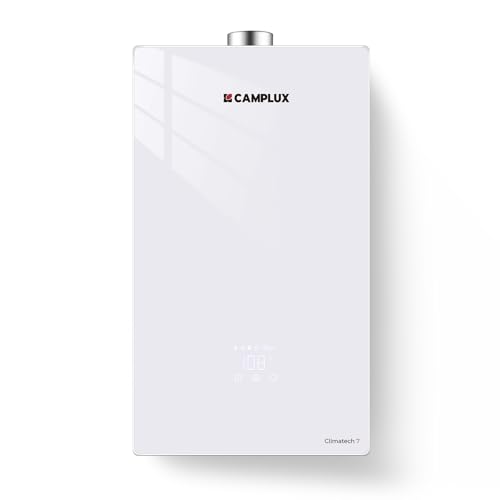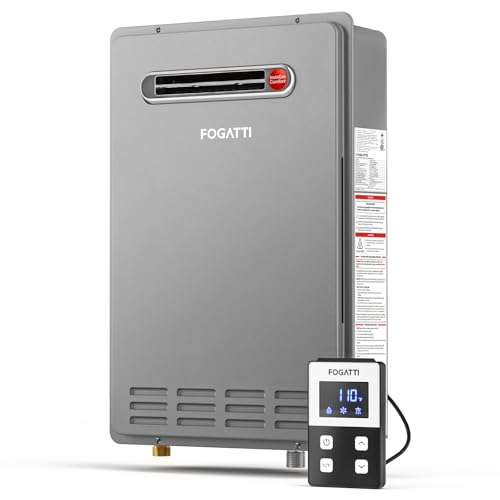Choosing the right gas hot water heater means matching capacity, installation type, efficiency, and safety features to your household needs. The table below summarizes five top tankless and on-demand gas units suitable for indoor and outdoor installation and for whole-house or targeted use.
| Product | Installation | Flow Rate (GPM) | BTU |
|---|---|---|---|
| Ranein Natural Gas Tankless | Indoor | 3.6 GPM | 80,000 BTU |
| Rinnai V75IN Tankless | Indoor | Up To 7.5 GPM | Manufacturer Rated |
| CAMPLUX Climatech 7 | Indoor | 6.86 GPM | 170,000 BTU |
| FOGATTI Instagas Comfort 180S | Outdoor | Up To 8.1 GPM | 180,000 BTU |
| ThermoMate 102,000 BTU | Indoor | 4.7 GPM | 102,000 BTU |
Content Navigation
- Ranein Natural Gas Tankless Heater
- Rinnai V75IN Tankless Hot Water
- CAMPLUX Climatech 7 Indoor Tankless
- FOGATTI Outdoor Instagas 180S
- ThermoMate 102K BTU Tankless Heater
- Buying Guide: How To Choose A Gas Hot Water Heater
- Capacity And Flow Rate (GPM)
- BTU Input And Temperature Rise
- Indoor Versus Outdoor Installation
- Energy Efficiency And Operating Cost
- Safety Features And Certifications
- Controls, Monitoring, And Convenience
- Installation, Gas Supply, And Venting
- Durability, Maintenance, And Water Quality
- Comparison Perspectives
Ranein Natural Gas Tankless Heater

This Ranein indoor tankless unit offers an 80,000 BTU rating with a maximum flow of 3.6 GPM, suited for 2–3 simultaneous fixtures such as a bathroom, kitchen, and bar sink. The on-demand design removes typical tank preheat waits, supplying continuous hot water as needed.
Included controls provide four preset modes—Dish (100°F), Fruit (95°F), Elderly (104°F), and Infant (107°F)—for task-specific temperature selection. The combination of mode presets and on-demand heating can enhance convenience for targeted uses where precise comfort temperatures are helpful.
Use cases for this unit include small to medium households or point-of-use installations that require controlled temperatures and steady supply for a couple of outlets. Installation considerations include adequate natural gas supply and indoor venting per local codes.
Rinnai V75IN Tankless Hot Water

Call 888-896-7031 for Free Local HVAC Quotes – Compare and Save Today!
The Rinnai V75IN is a compact indoor tankless model engineered to supply continuous, high-flow hot water up to 7.5 GPM, supporting multiple simultaneous outlets. Its design emphasizes energy efficiency by heating only when water is demanded, reducing standby losses.
Key system characteristics include scale detection to reduce long-term damage from hard water and an emphasis on maintaining consistent flow and pressure. The manufacturer positions this unit for homes needing reliable, whole-house supply without a storage tank.
Consider this model where higher flow rates are required, such as households with several bathrooms or multiple high-demand appliances. Proper venting, adequate gas piping, and professional sizing remain critical for optimal performance.
CAMPLUX Climatech 7 Indoor Tankless

The CAMPLUX Climatech 7 is specified at 170,000 BTU with a rated 6.86 GPM, indicating capacity for whole-house service and simultaneous use at multiple points. Notable engineered features include a copper heat exchanger and built-in freeze protection down to -20°F.
Bottom-fan technology with dual undercarriage blowers aims to prevent smoke backflow and maintain combustion stability. The unit claims rapid ignition and precise flame control to reduce temperature fluctuations during use.
Call 888-896-7031 for Free Local HVAC Quotes – Compare and Save Today!
This model is relevant for larger homes and colder climates where freeze protection, higher BTU input, and whole-house capability are required. Verify local venting requirements and fuel line sizing for safe and efficient operation.
FOGATTI Outdoor Instagas 180S

The FOGATTI Instagas Comfort 180S is built for outdoor installation with a high 180,000 BTU input and flow capability up to 8.1 GPM, targeting multi-outlet demands like several showers, sinks, and appliances simultaneously.
Designed for exterior mounting, it includes a remote control panel for indoor operation and a bottom-mounted fan to minimize smoke backflow. The four-stage combustion and precision water-servo controls aim to maintain a temperature variance within ±1°F.
Outdoor models reduce indoor venting complexity but require weather-resistant installation and adherence to local clearances. This unit is appropriate for properties that prefer exterior equipment placement while retaining high-capacity hot water delivery.
ThermoMate 102K BTU Tankless Heater

The ThermoMate tankless unit specifies 102,000 BTU with a 4.7 GPM flow, supporting 3–4 simultaneous fixtures. The product highlights include a high-efficiency oxygen-free copper heat exchanger and an advanced water flow sensor for temperature stabilization within ±1°F.
Safety systems listed include protections against boil-dry, flame failure, overheating, pipe blockage, and excessive air pressure. The manufacturer asserts thermal efficiency near 98% due to material and control design.
Choose this type of model for medium-sized households that prioritize safety protections, efficient heat transfer materials, and consistent temperature control across multiple fixtures.
Buying Guide: How To Choose A Gas Hot Water Heater
Selecting a suitable gas hot water heater requires assessing demand, installation constraints, efficiency, safety features, and long-term maintenance. The following considerations guide an informed choice across multiple comparison perspectives.
Capacity And Flow Rate (GPM)
- Match Flow To Demand: Estimate simultaneous fixture use (showers, dishwasher, washing machine). Typical shower use is 1.5–2.5 GPM. Add flows for concurrent use to size the unit.
- Whole-House Vs Point-Of-Use: Whole-house needs often require 6–8+ GPM; small point-of-use or 1–2 fixture setups can use 3–4 GPM units.
BTU Input And Temperature Rise
- BTU Correlates To Capacity: Higher BTU allows greater flow for higher incoming cold water temperatures. Evaluate the required temperature rise: required hot setpoint minus incoming groundwater temperature.
- Climate Impact: Colder climates need higher BTU to achieve the same flow at target temperature.
Indoor Versus Outdoor Installation
- Indoor Units: Require venting and often occupy utility spaces; options include more compact indoor models.
- Outdoor Units: Eliminate complex indoor venting but need weather-resistant construction and proper clearances.
Energy Efficiency And Operating Cost
- On-Demand Savings: Tankless gas heaters can cut standby losses versus tanks; check Uniform Energy Factor (UEF) when available.
- Heat Exchanger Material: Copper and oxygen-free copper offer high thermal conductivity; stainless steel is durable but has different efficiency characteristics.
Safety Features And Certifications
- Essential Protections: Look for boil-dry, flame failure, overheat, freeze, and flame-out protections depending on use case.
- Certifications: UL/CSA listing and local code compliance ensure equipment meets recognized safety standards.
Controls, Monitoring, And Convenience
- Remote Controls & Modes: Units with preset temperature modes and remote controllers simplify daily operation and can improve comfort settings.
- Real-Time Monitoring: Some models provide gas usage, voltage, and flow monitoring — useful for RV or mobile applications and for energy optimization.
Installation, Gas Supply, And Venting
- Professional Sizing: Gas line sizing, proper venting, and combustion air requirements are crucial for safety and performance.
- Local Codes: Verify local permitting and code requirements for indoor venting, condensate disposal, and outdoor clearances.
Durability, Maintenance, And Water Quality
- Hard Water Considerations: Scale detection and the ability to service or descale the heat exchanger extend service life in hard-water areas.
- Maintenance Access: Units with accessible panels and clear maintenance procedures reduce service time and costs.
Comparison Perspectives
- Small Household/Point Use: Lower GPM indoor models with preset temperature modes suit limited simultaneous demand.
- Whole-House High Demand: Higher BTU and GPM outdoor or indoor units support multiple showers and appliances concurrently.
- Outdoor Preference: Choose outdoor-rated models for simpler venting and exterior placement; ensure weatherproofing and freeze protection.
- Efficiency vs. Capacity Trade-Off: Higher capacity units may consume more gas at peak but deliver necessary flow; sizing for typical demand hours improves efficiency.
When selecting among brands and models, cross-reference the unit’s GPM, BTU rating, installation type, listed safety protections, and efficiency claims with your household needs and local installation requirements. Professional consultation for piping, venting, and code compliance is recommended prior to purchase and installation.
Tips for Getting the Best HVAC Prices
- Prioritize Quality Over Cost
The most critical factor in any HVAC project is the quality of the installation. Don’t compromise on contractor expertise just to save money. - Check for Rebates
Always research current rebates and incentives — they can significantly reduce your overall cost. - Compare Multiple Quotes
Request at least three estimates before making your choice. You can click here to get three free quotes from local professionals. These quotes include available rebates and tax credits and automatically exclude unqualified contractors. - Negotiate Smartly
Once you've chosen a contractor, use the proven strategies from our guide — How Homeowners Can Negotiate with HVAC Dealers — to get the best possible final price.
